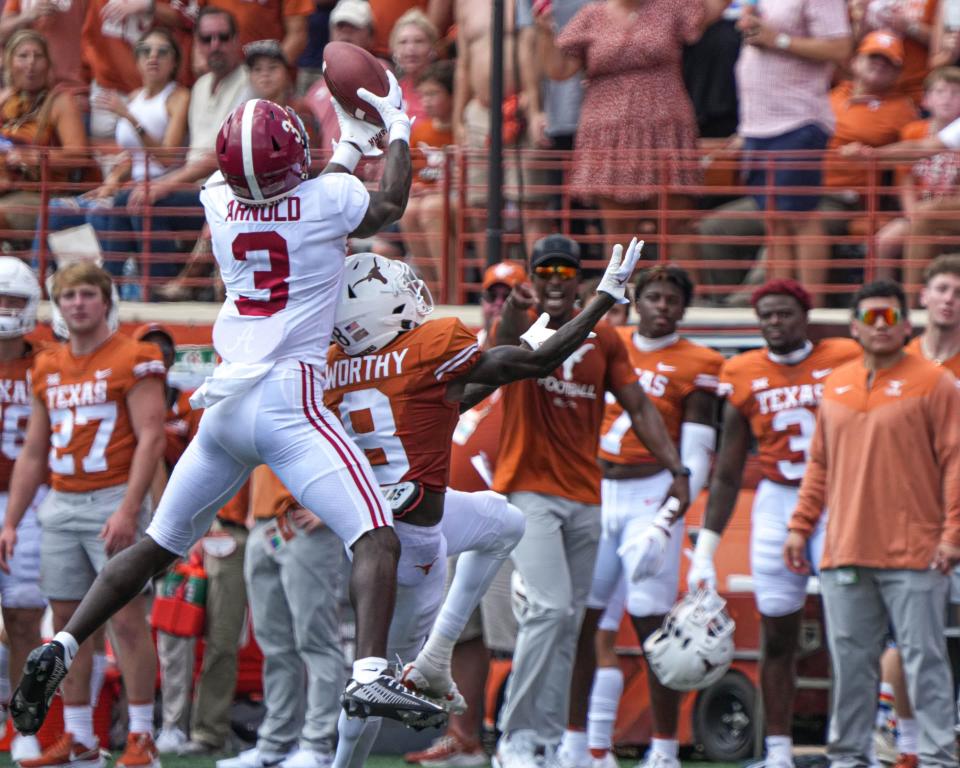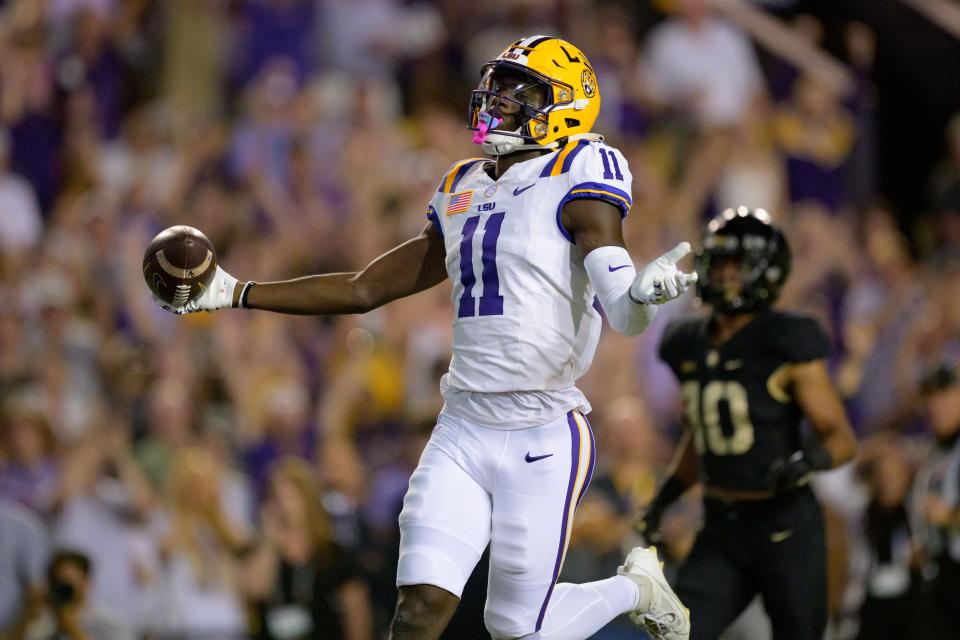Gene Frenette: Jaguars' 2024 rebound starts with avoiding misfires near top of NFL Draft
For the first time in franchise history, the Jacksonville Jaguars are drafting in the middle portion (slots 14-18) of the first round.
This year, the No. 17 position offers the Jaguars a wide assortment of options because some highly-valued prospects will likely be available at positions of greatest need (cornerback, receiver, D-line).
For Jacksonville, it’s lining up to be the most critical and fascinating draft in recent memory.
The marching orders for general manager Trent Baalke and his front-office team are quite simple: Don’t screw this up.
By no means is the Jaguars’ roster Super Bowl-ready, but that possibility exists if money spent on free agent acquisitions like Arik Armstead, Mitch Morse and others were good calls and they land a couple of impact starters in the draft.
It’s all contingent on correctly identifying those players, which hasn’t exactly been the Jaguars’ strength over the years. Of the NFL-high 20 picks the Jaguars have had in the top 10 since coming into the league in 1995, they’ve totally whiffed or failed to get proper value on about a dozen of them.
So can Baalke maximize their first two picks at No. 17 and No. 48, or wherever the Jaguars might end up selecting, and maybe grab a productive Day 3 pick to help Jacksonville ascend into a Super Bowl contender?
Here’s some random strategy thoughts on how the Jaguars can potentially make that happen:
More from Gene: Jaguars' history of drafting first-round receivers has been a complete bust
Trade up with abundance of caution
Due to the real possibility that the first tier of receivers (Ohio State’s Marvin Harrison, Jr., LSU’s Malik Nabers and Oregon’s Rome Odunze) and cornerbacks (Toledo’s Quinyon Mitchell, Alabama’s Terrion Arnold) may be off the board, many believe the Jaguars will be highly-tempted to trade up from No. 17.

First-round history, especially of this team, says Baalke better be awfully careful pulling that trigger.
Any trade of this magnitude — say jumping 4-10 spots — must be executed when the Jaguars’ trading partner is on the clock or they risk another team hunting the same prospect also trading up to get ahead of them.
Here’s the risk: trading into the bottom half of the top-10 would almost certainly involve the Jaguars giving up their No. 48 selection, which means losing the best asset to land another position of significant need.
Unless Baalke is convinced the prospect being targeted will be a multiple Pro Bowl player, it’s simply not worth the gamble.
The team’s draft resume of trading up in the first round illustrates that point. Pushing aside the 2022 deal of moving up six spots into the late first round (No. 27) to take linebacker Devin Lloyd, who has yet to play up to his selection, the Jaguars tend to lose out moving up in the first round.
They tried going from No. 7 to No. 5 with receiver Justin Blackmon (2012), from No. 16 to No. 10 with quarterback Blaine Gabbert, from No. 26 to No. 8 with edge rusher Derrick Harvey (2008). Each time, they wasted draft capital for colossal busts.
Jacksonville’s 1995 move from No. 31 to No. 19 for running back James Stewart — costing an additional supplemental third-round pick and two supplemental fourth-round selections — was the only win.
Trading down not a bad thing
As Baalke himself aptly put it last week at the team’s pre-draft media session: “If you’re going to move up, you better be right.”
That’s especially true in the first round, less so in the later rounds when trades don’t carry the same element of risk.
Depending on how the first round takes shape, it’s not inconceivable the Jaguars trade down. Baalke did it twice last year when moving from No. 24 to No. 25, then again to No. 27, before hitting on offensive tackle Anton Harrison and acquiring three Day 3 picks.
This year, moving down a few spots from the 17th slot — especially if the first-tier receivers and cornerbacks are gone — might be a smart play. If the Jaguars still have three or four players they like at those positions, they could fill a big need and pick up valuable draft ammunition to possibly move up in the second round.
But if a scenario unfolds where just one receiver (Brian Thomas) or one cornerback (Alabama’s Kool-Aid McKinistry) they covet is left on the board at 17, the Jaguars better not wait to pick.

Choosing right WR is dicey
It’s almost a given Harrison, Nabers and Odunze will be top-10 picks, maybe first six or seven, so the likelihood of the Jaguars nabbing any of them without paying a hefty price is a long shot.
Besides, few positions besides quarterback have proven more volatile in the first round of the NFL Draft than wide receiver.
From 2009-21, there were 15 receivers taken in the top-10. Only six truly lived up to the value of their draft slot, notably A.J. Green, Julio Jones, Amari Cooper and Ja’Marr Chase. Seven were busts, including two (Corey Davis, John Ross) in the 2017 draft, and, of course, Blackmon. Two others (Michael Crabtree, Mike Williams) had a couple splash seasons, but nothing spectacular.
The truth is you don’t have to move high up into the first round to find big-time weapons. The four best receivers from the 2020 draft were taken at No. 17 (CeeDee Lamb, Dallas Cowboys), No. 22 (Justin Jefferson, Minnesota Vikings), No. 25 (Brandon Aiyuk, San Francisco 49ers) and No. 33 (Tee Higgins, Cincinnati Bengals).
In that same draft, No. 12 (Henry Suggs, Las Vegas Raiders) and No. 21 (Jalen Reagor, Philadelphia Eagles) were busts, while No. 15 (Jerry Jeudy, Denver Broncos) has one decent season and got traded to Cleveland.
Now maybe Harrison, Nabers and Odunze beat the odds and all become perennial Pro Bowlers. Just don’t push the envelope with a crazy trade.
Patience can be a payoff
Besides, there appears to be enough receiver talent in this draft for the Jaguars to find a dependable weapon for Trevor Lawrence on Day 2.
“I think there’s good players like that all the way through the draft in that position,” said Baalke. “There’s going to be some later round guys that make a mark for themselves at some point in their careers in this league as well.”
The Jaguars’ defense has already been dented by two of those guys from the 2021 draft. Third-rounder Nico Collins of the Houston Texans and fourth-rounder Amon-Ra St. Brown of the Detroit Lions are performing like first-round talents.
Quality organizations find gems in the later rounds. When are the Jaguars going to do that?
Take advantage of deep draft
Imagine the Jaguars finding a Pro Bowl-caliber player from a Day 3 draft pick like they did with linebacker Telvin Smith (2017). It’d be a nice change.
Look at the Super Bowl champion Kansas City Chiefs. Among the weapons they found for Patrick Mahomes are running back Isiah Pacheco (2022, 7th round), tight end Noah Gray (2021, 5th round) and Tyreek Hill (2016, 5th round), a 6-time Pro Bowler with KC and twice more with the Miami Dolphins.
Two of the Los Angeles Rams’ biggest weapons, receiver Puka Nacua and running back Kyren Williams, were fifth-round picks the past two years.
The Jaguars are overdue for a knockout draft like in 2016 when they picked Jalen Ramsey, Myles Jack and Yannick Ngakoue. Granted, Ramsey and Ngakoue forced their way out of town, but they were an integral part of the 2017 team that came within an eyelash of reaching the Super Bowl.
It’s time to take full advantage of Lawrence’s potential by bolstering his surrounding cast, as well as fortifying the defense beyond Josh Allen, Travon Walker and Foye Oluokun.
That doesn’t have to always be done with home runs on Day 1 and 2. Baalke needs to find a late third-rounder (No. 96), and maybe at least one fourth-rounder (No. 114 or No. 116) who plays well above his draft slot.
Maybe it’s South Carolina’s Xavier Leggette, a 221-pound receiver with 4.39 speed who can double as a return man. Or possibly LSU defensive tackle Mekhi Wingo, who could be a three-technique in new coordinator Ryan Nielsen’s 40 scheme.
Who knows what will be available to the Jaguars in the later rounds, but it’s time to build a sustainable winner. The best way is to start drafting dependable starters good enough to earn second contracts, regardless of when they might get picked.
For Baalke and the Jaguars, another ho-hum draft — like getting run over by the Tennessee Titans in a Week 18 win-or-go-home matchup — is unacceptable.
The Jaguars’ future is on the clock.
Gfrenette@jacksonville.com: (904) 359-4540; Follow him on X, formerly Twitter, at @genefrenette
This article originally appeared on Florida Times-Union: Jaguars' GM Trent Baalke must match free agency success in 2024 NFL Draft | Frenette

